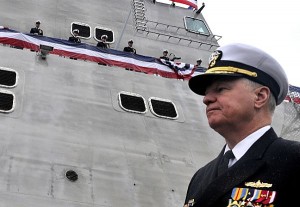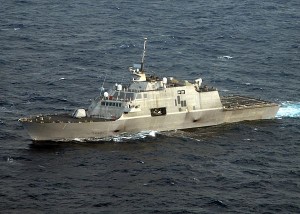Mulling the LCS down-select:
by Craig Hooper on February 12, 2010
 As the Littoral Combat Ship program faces an abrupt down-select to a single hull, the Navy must brace for some nasty litigation. The spurned party–either Lockheed or General Dynamics–will be poised to contest the selection process.
As the Littoral Combat Ship program faces an abrupt down-select to a single hull, the Navy must brace for some nasty litigation. The spurned party–either Lockheed or General Dynamics–will be poised to contest the selection process.
With little in the way of “real world” operational data available, advocates of either platform will have ample grounds to poke holes in the down-select’s Record of Decision (ROD).
If the Air Force’s $35 Billion dollar tanker down-select is any guide, this LCS down-select is going to be ugly.
It is a pity. With more resources, the Navy would have been busy building and evaluating two separate LCS squadrons, and the down-select years away.
Looking back, the outline for a “data-heavy” LCS down-select was put forth in 2004. Read Undersecretary of the Navy Robert Work’s essay from 2004, “Naval Transformation and the Littoral Combat Ship,” where he says:
“…the Navy would be advised to build at least two different operational prototypes. However, choosing two different prototypes will not completely resolve many of the operational issues. It seems clear that only by testing squadron prototypes will the Navy be able to fully resolve some of the outstanding issues surrounding the LCS and its support structure…”
Work isn’t going to get a firm test between LCS-1 and LCS-2 squadrons. By the time all four ships are available, the decision will be made.
That’s a little scary. Aside from the challenge of making a down-select decision with little data, the accelerated selection risks distorting LCS-1 operations.
I fear that the rapid down-select puts a lot of pressure on the deploying LCS-1 sailors to treat their platform gently. The opposite should be the case–the first model “Flight 0” platforms must be run hard, beaten up and, quite simply, broken. Broken early and often.
 Put bluntly, the Navy won’t learn much if problems are covered-up and the ship treated like a museum piece. (As an example, aside from keeping the production line going, what, exactly, did two years of babying the USS San Antonio (or hiding INSURVs) do for the LPD-17 program? I mean, how’s that USS New York Get Him Back Fast – Win Your Ex Boyfriend & Man – Earn 75% Per Sale!
Put bluntly, the Navy won’t learn much if problems are covered-up and the ship treated like a museum piece. (As an example, aside from keeping the production line going, what, exactly, did two years of babying the USS San Antonio (or hiding INSURVs) do for the LPD-17 program? I mean, how’s that USS New York Get Him Back Fast – Win Your Ex Boyfriend & Man – Earn 75% Per Sale!
-total.html”>treating y
a’ll?)
With enough hulls to form two LCS squadrons, the pressure to “take care of the showpiece” gets reduced. But with no squadron to share the risks, the Navy’s risk-averse chain-of-command needs constant reminding (along with some additional public top-cover and, on occasion, some prodding) that the first two LCS are test platforms–nothing more, nothing less. Break ’em and–for goodness sakes–tell folks you’re gonna break ’em!
And, just as an aside, barring obvious dereliction of duty, no penalty should be inflicted upon crew and commander, who, in the event their platform is not up for the mission at hand, goes and breaks the vessel.
That said, even when the Navy selects either LCS-1 or LCS-2 as the “LCS-of-record”, and the lawsuits get settled, I’d posit that the LCS down-selection still won’t be done.
Robert Work will get his squadron prototypes–and, again, in a couple of years, as the fiscal picture gets grimmer, the pressure to compare the LCS with the JHSV is going to be irresistible.
And that, simply put, is going to be an interesting battle.
My thoughts? If LCS-1 wins the initial down-select, the JHSV catamaran becomes a viable platform. (And given the minimum-cost focus of the LCS RfP–LCS-1 may well end up winning the LCS contract.) In that case, the JHSV gets a wide-open niche to go and exploit. Eventually, we’ll see a contest between a LCS-1 combat specialist and a do-anything up-gunned utilitarian JHSV.
It’ll be fascinating–and yes, as one of the first JHSV cheerleaders, I’m biased–but, as the civilian-crewed JHSV gets encumbered by more “combat-lite” duties, I can’t help but get a little anxious. Call me crazy, but I just don’t believe our model of using civilians for combat duty is gonna work very well. (Watch for more studies…)
If the LCS-2 wins, I don’t see why the Navy might want to keep the JHSV production line going for anything other than for risk-reduction. The JHSV and LCS occupy a similar sort of “truck-like” niche (Or, to use a “Workism”, their “boxes” are pretty similarly-sized). A civilianized LCS-2 is just a trimaran JHSV, right?
Look, a civilianized model of the LCS-2 is available right now. Rent it. If the LCS-2 hull-form works for the Navy, then wouldn’t it be appropriate to leverage savings that would stem from using the same hull-form, similar plant, identical layout and matching broad-based operational template?
If we use the same hull-form for both the JHSV and LCS-2, would it not be super-easy to, if necessary, swap out civilian crews? As the line between “combat” and “combat support” continues to shrink, it might be really useful to have the ability to seamlessly swap out civilians with a combat-ready Navy crew.
All in all, it’s going to be an interesting year. (And, just FYI, I’m betting the LCS-1 breaks on its upcoming deployment.)
zp8497586rq
zp8497586rq
Tagged as:
JHSV,
LCS,
Littoral Combat Ship,
shipbuilding
 As the Littoral Combat Ship program faces an abrupt down-select to a single hull, the Navy must brace for some nasty litigation. The spurned party–either Lockheed or General Dynamics–will be poised to contest the selection process.
As the Littoral Combat Ship program faces an abrupt down-select to a single hull, the Navy must brace for some nasty litigation. The spurned party–either Lockheed or General Dynamics–will be poised to contest the selection process. Put bluntly, the Navy won’t learn much if problems are covered-up and the ship treated like a museum piece. (As an example, aside from keeping the production line going, what, exactly, did two years of babying the USS San Antonio (or hiding INSURVs) do for the LPD-17 program? I mean, how’s that USS New York Get Him Back Fast – Win Your Ex Boyfriend & Man – Earn 75% Per Sale!
Put bluntly, the Navy won’t learn much if problems are covered-up and the ship treated like a museum piece. (As an example, aside from keeping the production line going, what, exactly, did two years of babying the USS San Antonio (or hiding INSURVs) do for the LPD-17 program? I mean, how’s that USS New York Get Him Back Fast – Win Your Ex Boyfriend & Man – Earn 75% Per Sale! 
{ 1 comment }
As a retired naval officer with dated, but potentially applicable skills from Vietnam tours ashore and afloat and Aegis, I’d like to get involved in LCS or JHSV work. Any ideas?
Comments on this entry are closed.